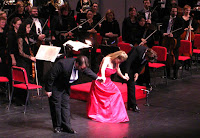 It’s kind of fun to search blogs for comments on things that you yourself went to. Since I’ve been writing about the SICB meeting, I looked for that and found this post, which had good presentation advice. So I thought I would elaborate on it.
It’s kind of fun to search blogs for comments on things that you yourself went to. Since I’ve been writing about the SICB meeting, I looked for that and found this post, which had good presentation advice. So I thought I would elaborate on it.I was reading a book on magic once, and the author said it was important when you finished an illusion to bow. Now, he immediately elaborated that he didn't literally mean “bend at the waist.” He meant that you should do something to indicate clearly that the trick was done. It was also important not to immediately start the next one, but to create a space for the audience to show their appreciation – to applaud.
Because people’s attention may drift, it’s also helpful to cue them that the talk is coming to a close. Say something like, “In conclusion...” or “To sum up...” or “The take home message is...”.
Several bad ways to end a presentation include:
- Just not talking. Definitely the worst way to go, as people are really unsure of whether they should listen or clap.
- Ending with a perfunctory, “That’s it,“ or “That’s all.” This is usually thrown in as a desperate sign to the audience after the above method (just not talking) fails.
- Anything mentioning questions (as in the linked blog post), as people don’t know if they should stick up their hands or clap.
My typical way to end is to put up an acknowledgments slide, which I do not read, but leave it up during questions. Then, I say, “I thank these people for help with my science, and I thank you for your attention.”
By thanking the audience, you create a chance for them to say, “You”re welcome,” with their applause.

No comments:
Post a Comment